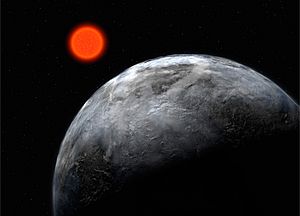Gliese 581 c facts for kids
Gliese 581 c is a planet that orbits a star far away from our Solar System. Scientists call these planets exoplanets. This exoplanet circles a star named Gliese 581, which is a type of star called a red dwarf.
Gliese 581 c is about 20 light-years from Earth. You can find it in the direction of the Libra constellation. This planet is much bigger than Earth. It is about six times as heavy as our home planet.
Gliese 581 c orbits its star very closely. It is only about 11 million kilometers away from Gliese 581. To compare, Earth is about 150 million kilometers from our Sun. Gliese 581 c completes one trip around its star in just 13 Earth days. When it was found in 2007, scientists thought it might be a lot like Earth and could even have life.
Could Gliese 581 c Support Life?
When Gliese 581 c was first found, scientists were excited. They thought it might be in the "habitable zone". This is the area around a star where it's not too hot and not too cold for liquid water to exist. Liquid water is very important for life as we know it.
However, later studies showed that Gliese 581 c might be too close to its star. It could suffer from a strong greenhouse effect. This is like what happens on Venus, where gases in the atmosphere trap a lot of heat. If this is true, Gliese 581 c would be extremely hot and not able to support life.
Also, red dwarf stars like Gliese 581 can be quite active. They often send out strong bursts of energy called solar flares. These flares could be harmful to any life trying to survive on a nearby planet.
What is Tidal Locking?
Gliese 581 c might be "tidally locked" to its star. This means that one side of the planet always faces the star, just like one side of our Moon always faces Earth. If a planet is tidally locked, its day would be as long as its year.
Tidal locking also means the planet would not have any axial tilt. This means it would not experience different seasons like Earth does. One side of the planet would always be in daylight, and the other side would always be in darkness.
Even with these extreme conditions, some scientists think there might be a narrow strip of land between the super-hot day side and the super-cold night side. This "twilight zone" could potentially have temperatures that are just right for liquid water and maybe even life.
See also
 In Spanish: Gliese 581 c para niños
In Spanish: Gliese 581 c para niños


